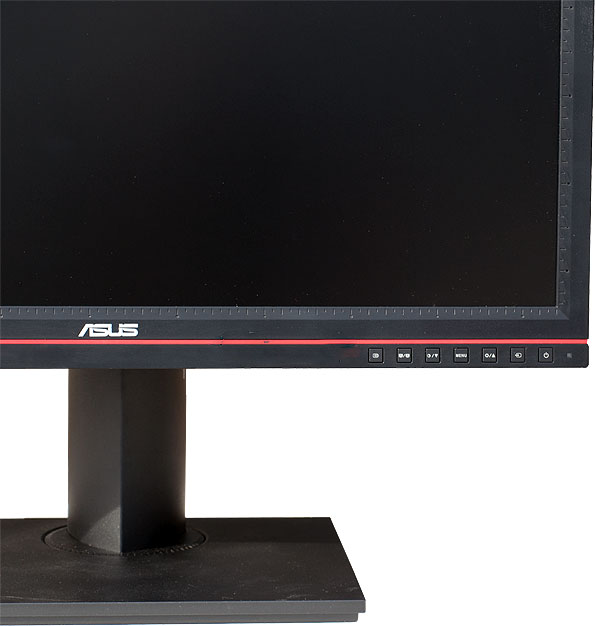Asus PA246Q ProArt 24-Inch LCD Monitor Review
Calibration & Controls
We should reiterate here that Asus pre-calibrates each PA246Q monitor at the factory, which is great if you just want to fire it up and be ready to go. At the same time, if you're working on a mission critical project, you may have no choice but to tinker with the color settings. We've learned never to take on-screen display (OSD) controls for granted (we're looking at you, HP ZR30w), and whether you plan to use them or not, Asus includes them.

At a time when touch-sensitive buttons are all the rage, Asus played it smart and stuck with good old-fashioned buttons. What's our beef with touch-sensitive controls? Put simply, they're often janky. It's frustrating to mash a button two or three times only to have it finally register on the fourth attempt.
The OSD on the PA246Q isn't completely intuitive, but for the most part, you'll be jumping through the menus like a pro after you spend a few minutes familiarizing yourself with the layout. Depending on which input you're using, there's a fair amount to play with, such as brightness, contrast, saturation, hue, color temperature, gamma, sharpness, focus, and more. Asus also includes a handful of image quality presets: Standard Mode, sRGB Mode, Adobe RGB Mode, Scenery Mode, Theater Mode, and User Mode. One of the buttons serves as a hotkey that cycles through these modes.
The OSD on the PA246Q isn't completely intuitive, but for the most part, you'll be jumping through the menus like a pro after you spend a few minutes familiarizing yourself with the layout. Depending on which input you're using, there's a fair amount to play with, such as brightness, contrast, saturation, hue, color temperature, gamma, sharpness, focus, and more. Asus also includes a handful of image quality presets: Standard Mode, sRGB Mode, Adobe RGB Mode, Scenery Mode, Theater Mode, and User Mode. One of the buttons serves as a hotkey that cycles through these modes.
Perhaps one of the most useful features is another hotkey that brings up what Asus calls the "QuickFit Virtual Scale" (see video above). You use this hotkey to cycle through an alignment grid; a pair grids in inches and centimeters so you know exactly how big the picture or document on screen will print out; and letter (A4), document, and photo outlines of various sizes to help you resize images exactly as you need them printed. When all else fails, the PA246Q's bezel comes notched with both centimeters and inches, so you'll never need to go sticking your hand in the kitchen junk drawer looking for that ruler you know you have somewhere.
|
We're now using DisplayMate for Windows (www.displaymate.com) as part of our monitor evaluation process. DisplayMate's smorgasbord of tests allow us to root out potential problems areas, such as geometry distortion and color inaccuracies, to name just two.
One thing that really stood out to us with the PA246Q was the brightness. Out of the box, the monitor's picture was gorgeous and vibrant, but not washed out. Compared to one of Asus' lower-end TN panels we had a bad experience with in the past, where the picture was tinted blue and required lots of fiddling to correct, the PA246Q stood head and shoulders above.
Color reproduction was excellent, we didn't notice any backlight bleeding, and the gray scale test was visible down to level 2, which is fantastic. And this was without any tinkering. Overall, performance was akin to NEC's PA271W.

One thing that really stood out to us with the PA246Q was the brightness. Out of the box, the monitor's picture was gorgeous and vibrant, but not washed out. Compared to one of Asus' lower-end TN panels we had a bad experience with in the past, where the picture was tinted blue and required lots of fiddling to correct, the PA246Q stood head and shoulders above.
Color reproduction was excellent, we didn't notice any backlight bleeding, and the gray scale test was visible down to level 2, which is fantastic. And this was without any tinkering. Overall, performance was akin to NEC's PA271W.

Photos look incredible on the PA246Q, so long as you don't use the Scenery or Theater Mode presets. Standard, sRGB, and Adobe RGB produced the best looking images (no big surprise there), with the latter two displaying slightly more accurate colors.
The viewing angle was also superb. Granted you're not going to be doing a lot of serious work at extreme angles, but the PA246Q allows you to move around without worrying about having to remained fixed front and center.
The viewing angle was also superb. Granted you're not going to be doing a lot of serious work at extreme angles, but the PA246Q allows you to move around without worrying about having to remained fixed front and center.










